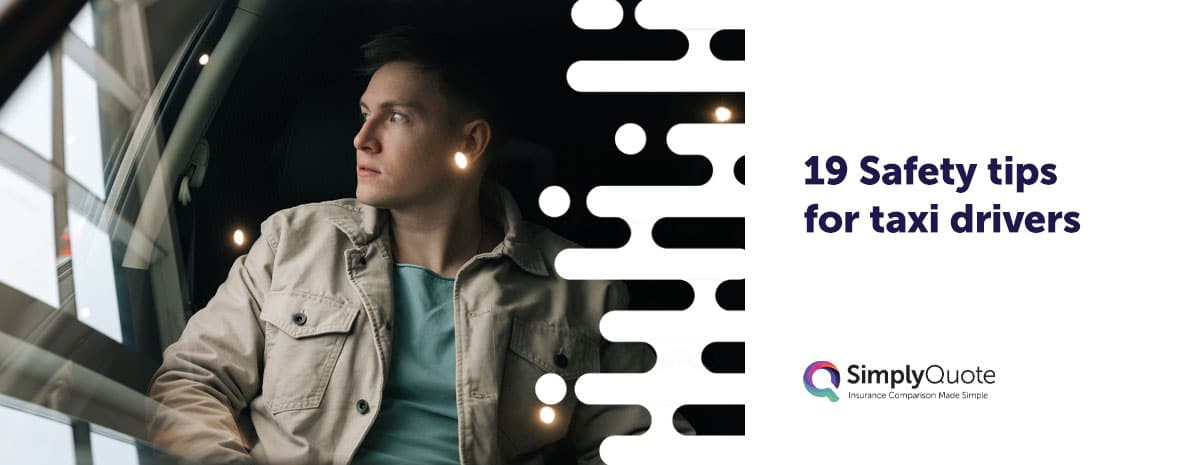19 Safety tips for taxi drivers
Taxi drivers need to remain alert, be able to “read” passengers, safeguard their cash, and know how to handle emergencies.
The taxi industry is high-risk and drivers must know how to stay safe. After all, they are not only responsible for their safety, but also for their vehicle, passengers, and earnings.
In this guide, we’ll outline 19 tips on how you can protect yourself as a taxi driver.

7 Personal safety tips
A taxi driver’s safety can often be overlooked, but they are just as vulnerable as their passengers.
Let’s look at some safety measures you can use while carrying out your shifts without compromising the integrity of your service.
1. Stay alert at all times
You should avoid fatigue to remain alert, regardless of whether you are driving or parked.
This is a demanding job and can be physically, mentally, and emotionally draining.
Here’s how to deal with it:
- Do not overwork yourself. Know your limits and take regular breaks in a safe area.
- Stay well-hydrated and eat foods that won’t spike your blood sugar levels.
- Get enough sleep when you are not on duty.
- Be mindful of the Driver’s Hours for GB and Rules on Drivers’ Hours and Tachographs – Passenger Vehicles in Northern Ireland.
Bonus read: Taxi Driver Shifts Explained
2. Avoid high-risk areas
Drivers should have extensive knowledge of the areas in which they operate. Some are known to be dangerous at all times, while others pose more of a risk at certain times of the day or night.
Keep in mind that risk is not limited to criminal activity or behaviour, but includes extreme weather conditions where roads may be too unsafe to use.
Here’s how to avoid high-risk areas:
- Know which areas in your local authority are crime-ridden.
- Avoid fares that require pick-ups or drop-offs in risky areas.
- Stay updated with local news about the happenings in the areas where you work.
- Join platforms where taxi drivers can communicate real-time incidents.
- Adhere to any weather warnings.
- Use apps, such as Waze, that report on-road closures, road works, or construction.
Bonus read: Best Apps For Taxi Drivers
3. Keep your personal information private
Do not disclose personal information about yourself or your family that could be used against you. While it’s natural to engage in conversation, you should be politely vague when chatting with strangers.
Drivers should use their discretion and instincts when it comes to what they share with passengers.
4. Learn how to “read” passengers
Getting a good read on a passenger could lessen the chances of something bad happening. A taxi driver encounters all kinds of passengers and should develop a keen sense of reading people – essential in this line of work.
You must learn when to engage in conversation, keep quiet, or be on alert.
When reading a passenger:
- Maintain eye contact.
- Take note of sketchy behaviour, such as trying to conceal their face.
- If possible, make sure they do not sit directly behind you.
5. Know when to refuse service
As a taxi driver, it is within your right to refuse service under the following circumstances:
- The passenger appears to be drunk.
- The passenger displays aggressive behaviour.
- The passenger’s request is unreasonable.
In the event that a fare is refused, be sure to note the date, time, location and reason for refusal.
Bonus read: How To Be A Good Taxi Driver
6. Keep windows rolled up and doors locked
Whether you are driving or parked, the windows and doors of your cab should be rolled up and locked. These are points of entry for criminals and having them open makes taxi drivers easy targets.
If you drive a saloon car, do not allow passengers access to the front of the vehicle and keep the dividing window closed as much as possible.
7. Report any incidents
Should you fall victim to a crime, write down as much detail as possible relating to the incident. If there are any bystanders, ask them if they would be willing to provide a witness statement to validate your report to the authorities.
Bonus read: Taxi Driver Problems And How To Deal With Them
Looking for cheap taxi insurance? Get your quote today!
Get Quotes6 Vehicle safety tips
A taxi driver’s vehicle is their entire livelihood. Precautionary measures must be taken to ensure that your vehicle is not placed in unsafe situations.
1. Stay updated with vehicle maintenance and safety checks
It is a legal requirement for licensed taxi drivers to stay updated with any vehicle services and maintenance.
Be sure to check the MOT status of your vehicle to remain compliant with industry regulations.
Bonus read: Vehicle Checks For Uber Drivers
2. Know your nearest refuelling points or charging stations
Most taxi drivers know where to fill up if they are within their main area of operation. However, if you find yourself in unfamiliar territory, apps such as AroundMe come in handy. These apps provide locations of the nearest amenities, such as petrol stations or, in the case of hybrid cabs, charging stations.
3. Have a comprehensive insurance policy
Taxi insurance is another legal requirement for public and private hire drivers. Your insurance policy should be comprehensive and provide sufficient cover when you need it.
Depending on the type of driving you do, it’s a good idea to have:
Additionally, consider adding public liability insurance to your policy.
4. Invest in equipment and technology
There is specific equipment and technology that every taxi driver should have to improve their safety.
These include:
- Tracking apps on mobile phone devices or telematics insurance
- Dashboard cameras
- CCTV within the cab
- Two-way radios
- Panic button
Bonus read: Why Private Hire Drivers Need A Dash Cam
5. Carry a spare key
A spare should be kept on the taxi driver, concealed in a pocket. If a robbery occurs, the perpetrator will likely throw the vehicle’s keys away or take off with them to discourage a chase.
This is also good practice as keys have a way of disappearing.
6. Don’t accept fares to an unspecified location
A taxi driver should never accept a fare where the drop-off or pick-up location is not exact. This places them in a vulnerable position and should be avoided.
Before accepting the fare, politely insist that the specific location be provided. Drivers should also avoid pick-ups or drop-offs in back lanes and alleys.
3 Money-handling safety tips
Drivers are often targeted because they are known to carry cash. While limiting the amount of money you carry is not always possible, there are ways to lessen the chances of being targeted.
1. Do not display cash
When dealing with cash, always have a small amount of money on hand to provide change to a passenger.
Keep most of your cash in a discrete location, out of sight.
2. Never disclose details about your shift
If a passenger enquires about your shift, they may just be making conversation. However, they could also be trying to decipher how much cash you have on you. If you tell them that you’ve had a “good shift” or that it has been “really busy”, this can be interpreted as a lucrative shift.
You can still engage in conversation but be sure to downplay your shift if it has been especially busy. Alternatively, you could say that you only just started with your duties for the day.
3. Encourage the use of credit or debit cards
If you are a public hire driver, it’s harder to stipulate payment methods. Having card facilities in your cab will be beneficial, as many people prefer cashless payments.
Private hire drivers, on the other hand, have the luxury of stipulating that only card payments are accepted. This removes the threat of a cash robbery and makes them less vulnerable.
Bonus read: Is It Worth Being A Taxi Driver In The UK?
3 Emergency safety tips
A taxi driver is responsible for the safety of their passengers and must know what to do in an emergency.
1. Know emergency procedures for various situations
No matter what the situation, the first thing you need to do is stay calm.
Here’s what to do in specific situations:
In an accident: A taxi driver has a duty of care to their passengers. They must assist injured passengers as far as they can, and alert necessary authorities immediately.
Robbery or assault: Taxi drivers must remain calm and comply with the robber. Try to de-escalate the situation and hand over any requested money or items. Take note of any distinctive clothing but do not make excessive eye contact.
Passenger has become ill: Contact the appropriate authorities and transport the passenger to the nearest hospital for medical attention.
2. Keep a fully stocked emergency kit
All cabs should have a fully stocked emergency kit, which includes a first aid kit. This will be helpful in time-critical situations should medical personnel not be available immediately.
This kit should include:
- A torch
- Phone charger
- Reflective vest
- Basic tools
- Bottled water
It’s in your best interest as a cab driver to undergo first aid training.
Additionally, all public hire and private hire vehicles are legally required to have a water or foam fire extinguisher with at least a two-litre capacity at all times. This will also require regular servicing.
3. Have emergency contact numbers on hand
Emergency contact numbers should be easily accessible with a hard copy kept in the vehicle. This allows passengers to call the correct authorities, such as the police or ambulance, should the driver be unable to.
Final thoughts
The tips provided here will help you keep yourself and your passengers safe during your shifts. Remember that there is no greater judge of a character or situation than your own instincts.
For more guides on the various facets of the taxi industry, be sure to check out SimplyQuote‘s resources.
Frequently Asked Questions
No, taxi drivers and civilians are not permitted to carry any kind of weapon in the UK. This includes pepper spray. Any taxi driver found with such items will face legal charges and may have their licence suspended or revoked.
Yes, dash cams and CCTV are allowed to be used in taxis. However, drivers must comply with data protection regulations and inform passengers that they are being recorded.
If you suddenly feel unsafe with a passenger, remain calm and drive to a well-lit, populated area. Calmly inform the passenger that you are unable to complete the fare. If you are unable to stop the car, try to dial 999 discretely or press your vehicle panic button.
